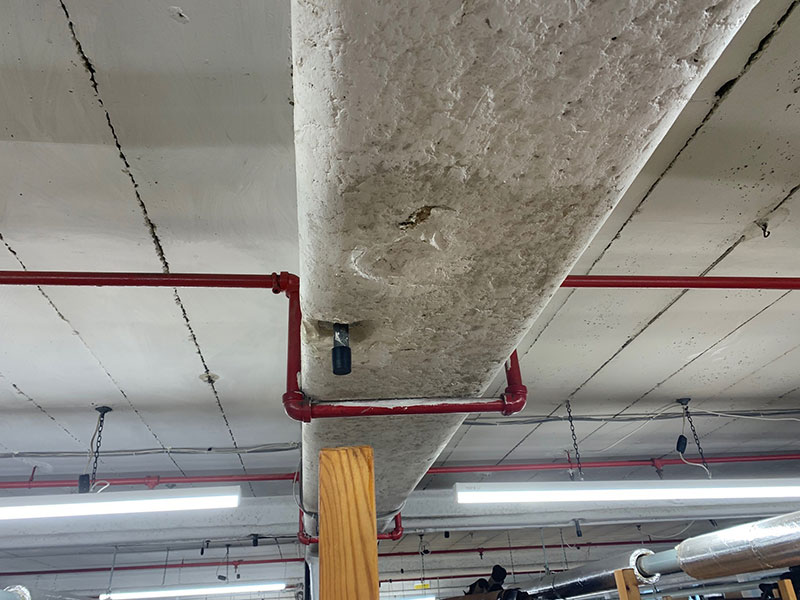Asbestos Material Assessment Explained
When you are looking to manage the risk that asbestos poses on premises for which you are responsible, it will be crucial to carry out an effective assessment of the asbestos-containing materials (ACMs) that are found on your site.

What is an asbestos material assessment?
An asbestos material assessment involves an asbestos surveyor assessing ACMs on a given site, and making a judgement of the risk those materials pose – including the chances of someone disturbing these notoriously carcinogenic materials. Such disturbance could cause the ACMs’ fibres to be released and subsequently breathed in by someone nearby.
It is not only the mere fact of asbestos being present on your premises that will determine the exact level of risk.
This is why an asbestos material assessment is very much concerned with what the exact material is – for example, whether it is cement board, insulation, or something else – as well as what type of asbestos is involved, and its condition.
Each aspect of the assessment is then scored to help determine the risk that the ACMs pose, and what steps the dutyholder will need to take in managing them.
When do I need an asbestos material assessment?
Regulation 4 of the Control of Asbestos Regulations 2012, or CAR 2012, set outs a “duty to manage” asbestos in non-domestic premises. The person who has the duty – otherwise known as the “dutyholder” – is the person who owns the given premises, or the person or organisation with clear responsibility for maintaining or repairing the premises.
If you are a dutyholder for a particular non-domestic premises, you will need to take reasonable steps to find out whether there are ACMs in the buildings for which you are responsible – and if so, the location, amount, and condition of those materials. It will also be necessary for you to make, and keep up to date, a record of the location and condition of the ACMs.
For many non-domestic premises, it is practically essential to arrange for an asbestos management survey to be carried out on the site. The aim behind an asbestos management survey is to create an ‘asbestos register’, which will set out where the asbestos is located on the given site, or where asbestos might be located (in the case of materials that are suspected to be asbestos).
For each entry in your asbestos register, it will be necessary to state a material score and a priority score. This will help you to determine what ACMs on your site most urgently require action, as well as what specific actions you should take to manage the asbestos.
Knowing this information, and making those decisions, will then enable you to write an asbestos management plan, which is another requirement for dutyholders under CAR 2012.
What is the scoring system for an asbestos assessment?
As mentioned above, both a material score and a priority score will need to be recorded for the materials mentioned in your asbestos register. The items with the highest priority score will be those you should prioritise for action first; if there are multiple items in your asbestos register with the same priority score, you should first act on the items with the highest material score.
The scoring system for an asbestos material assessment covers four parameters: product type, the extent of damage or deterioration, surface treatment, and asbestos type. A score is required for each of these parameters, and adding those four scores will give you an overall Material Assessment Score.
Below is a summary of the Health and Safety Executive (HSE)’s Material Assessment algorithm:
Product type (or debris from product)
- Score 1 (low risk): Asbestos reinforced composites such as plastics, resins, roofing felts, mastics, vinyl floor tiles, asbestos cement, or semi-rigid paints or decorative finishes
- Score 2 (medium risk): Asbestos insulating board, mill boards, other low density insulating boards, gaskets, asbestos tiles, asbestos paper and felt, ropes and woven textiles
- Score 3 (high risk): Thermal insulation such as pipe and boiler lagging, as well as such materials as sprayed asbestos, loose asbestos, asbestos mattresses and packing
Extent of damage or deterioration
- Score 0 (no risk): Good condition: no visible damage
- Score 1 (low risk): Low damage: a few scratches or surface marks; broken edges on boards, tiles etc
- Score 2 (medium risk): Medium damage: significant breakage of materials or several small areas where material has been damaged, revealing loose asbestos fibres
- Score 3 (high risk): High damage or delamination of materials, sprays, and thermal insulation. Visible asbestos debris
Surface type or treatment
- Score 0 (no risk): Composite materials containing asbestos: reinforced plastics, resins, vinyl tiles
- Score 1 (low risk): Enclosed sprays and lagging, asbestos insulating board (with exposed face painted or encapsulated), asbestos cement sheets etc
- Score 2 (medium risk): Unsealed asbestos insulating board, or encapsulated lagging and sprays
- Score 3 (high risk): Unsealed laggings and sprayed asbestos
Asbestos type
- Score 1 (low risk): White (chrysotile) only
- Score 2 (medium risk): Brown (amphibole asbestos excluding crocidolite) and mixtures (not blue)
- Score 3 (high risk): Blue (crocidolite) and mixtures or type unknown
With regard to asbestos type, HSE advises that presumed or strongly presumed ACMs are scored as crocidolite (3) unless analysis of similar samples from the same building shows a different type of asbestos, or a reasoned argument can be made that an alternative asbestos type was nearly always used. In other words, if you are in any doubt, you should score 3.
Add these scores together to come up with a Material Assessment Score out of 12. The total score that you come up with for each item can be interpreted as indicating the potential the material has to release fibres, as set out below:
- 4 or below: very low potential to release fibres
- 5-6: low potential to release fibres
- 7-9: medium potential to release fibres
- 10 or above: high potential to release fibres
What should you do with the asbestos material assessment results?
The results of your asbestos survey should be summarised in a table format. The information should be presented on an individual room basis, with any rooms or areas that have not been accessed – and that are presumed to contain asbestos – also being included in the table.
It should be noted that an asbestos material assessment will only assess the actual material; priority risk assessments consider other factors. If your asbestos survey included a priority assessment, the priority scores should be listed in the table, along with highlights of any action required. Asbestos surveyors should only undertake a priority assessment in consultation with the client or dutyholder, who is required to provide accurate information on all the activities carried out on the site.
Once you have written the scores for each asbestos material on your premises in your asbestos register, you will be able to decide how to deal with the different types of ACMs – such as cement, sprayed asbestos, lagging, asbestos insulating board, or other materials – that you might have found on your site. If you are unsure about any aspect of this, you are advised to seek advice from a licensed asbestos contractor or surveyor.
From here, you will be able to put together your asbestos management plan. This will include such elements as who is responsible for managing asbestos in the buildings, the asbestos register you have just assembled, your plans for working on the asbestos materials, the schedule for monitoring the condition of the materials, and letting people know about the decisions you have made.
The Oracle Solutions team stands ready to provide advice, assistance, and a competitive quote for any of a wide range of asbestos management services, including – but not limited to – asbestos sample testing, surveying, and removal. Feel free to send us an email, or to call us to discuss your circumstances and requirements with our experts.

Written by Mark Carter
Mark Carter is a renowned expert in asbestos management, offering clients vital guidance on compliance and safety. His expertise is invaluable for navigating asbestos regulations, ensuring both safety and legal adherence. Mark's role is central in providing effective asbestos-related solutions, helping clients achieve their business objectives with an emphasis on regulatory compliance and safety in asbestos management.
